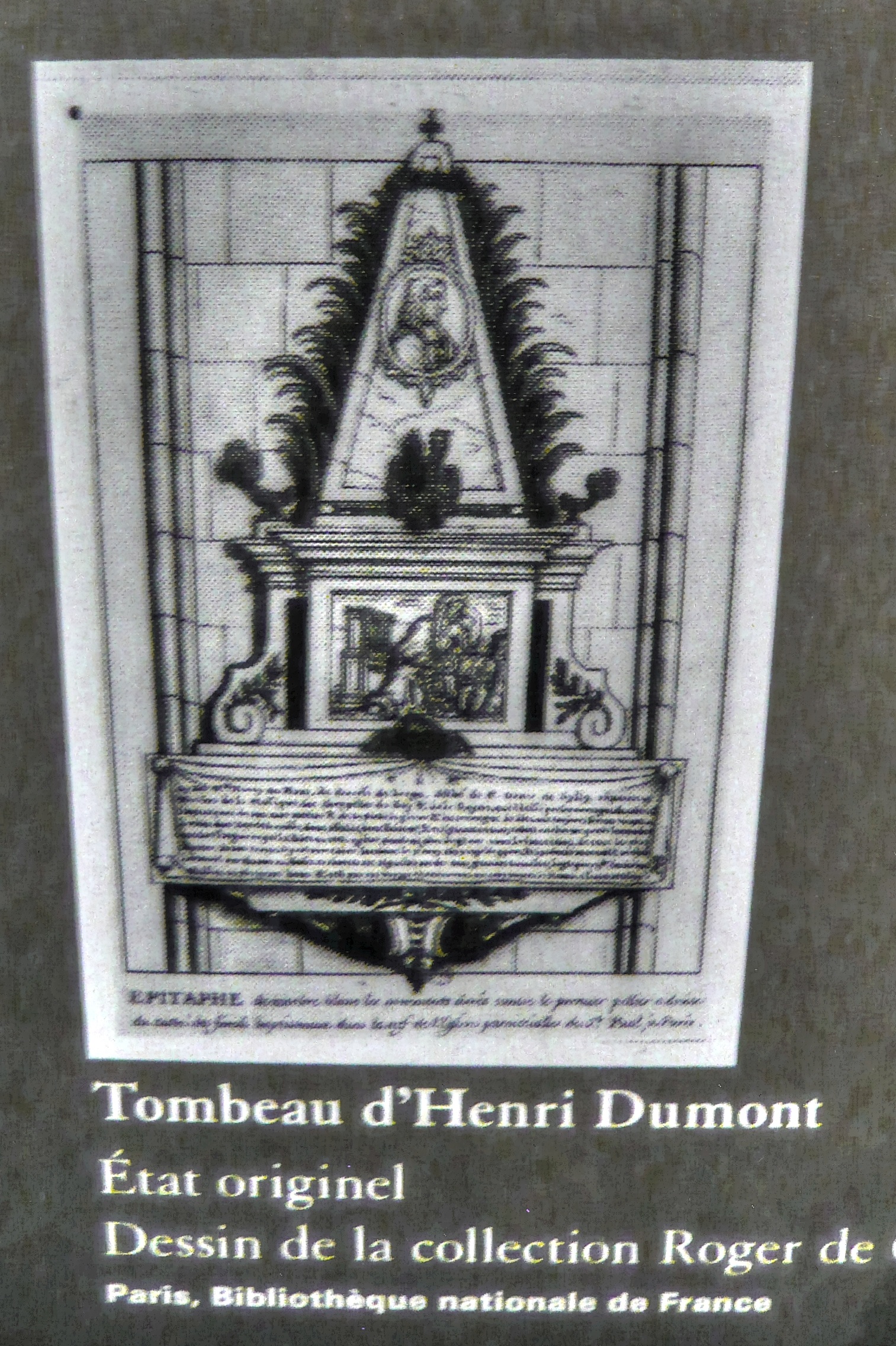 The
Ranums'
The
Ranums'
Panat Times
Volume 1, redone Dec. 2014
The portrait of Henri Du Mont,
was it based on the bust on his
tomb at Saint-Paul?
In my presentation of the watercolor portrait said to represent
Marc-Antoine Charpenti er,
I made the following comment about the watercolor portrait of Henri Du
Mont: "The original portrait of Henri Du Mont conveys considerable depth
by the gently graded shading of the features, as in a sculptured bust.
Indeed, his hair is shaped into sculptured, mop-like strands. (Was this
watercolor based upon the bust that decorated Du Mont's tomb at the
Church of Saint-Paul?)"
er,
I made the following comment about the watercolor portrait of Henri Du
Mont: "The original portrait of Henri Du Mont conveys considerable depth
by the gently graded shading of the features, as in a sculptured bust.
Indeed, his hair is shaped into sculptured, mop-like strands. (Was this
watercolor based upon the bust that decorated Du Mont's tomb at the
Church of Saint-Paul?)"
I think about this possibility now and then — most recently after a long visit to the sculpture section of the Louvre. That day, after studying the mid-relief of a female musician that survived the destruction of the church in 1799, I photographed the reproduction of the drawing of the entire tomb commissioned by Roger de Gaignières in the late seventeenth or early eighteen century.


Even the most cursory glance at the female musician reveals that the drawing made for Gaignières is extremely schematic. Indeed, the same thing can be observed for the other tomb sculptures in that section of the Louvre that were drawn for Gaignières and whose label includes a reproduction of the Gaignières drawing.
Despite its awkwardness, the Gaignières drawing permits us to imagine Du Mont's tomb, and its structure. The lowest of the three superimposed components represented a coffin over which a (stone) cloth bearing an inscription was spread. Above that was the mid-relief with the female musician. This was topped by a pyramid-shaped cenotaph ornamented with a stone bust of the deceased. Judging from the drawing, it was executed either in low-relief or mid-relief. Du Mont gazes to the right. His forehead is covered by bangs, and the rest of his hair hangs in curls that are a bit longer than shoulder-length. He seems to be dressed in a cleric's robe or loose mantle with a bit of ornamentation that runs down the central closing. His linen collar hangs down in front, some eight inches.
In writing the above paragraph, I could of course be describing the watercolor labeled as Henri Du Mont, owned by the University Library of Frankfurt am Main! The subject looks to the right; his coiffure is very similar to the one in the Gaignières collection; his white linen collar hangs down at least eight inches in front, and below it, his voluminous robe is ornamented with a vertical row of small buttons.
The similarities may all be a coincidence. Still, when the portrait and the musician are converted to black and white and positioned as in the Gaignières drawing, this is the result:
To my perhaps overly optimistic eyes, the two photos could depict two mid-relief elements of the lost tomb — one of them the real thing, and the other element "translated" by a later artist into a different medium and given a coloration lacking in the original.
Can this comparison teach us anything about the authenticity of the
three watercolors of Frankfurt-am-Main? I think it can — if, that is,
one is willing to entertain the possibility that the Frankfurt drawing
is not a fake done in the late nineteenth or early twentieth century, on
a piece of old paper.
Old paper: according to
Otto Eckle, the paper of the Du Mont
portrait bears the watermark "AUVERGNE1742." This means one of two
things. Either this watercolor (and the ones of Charpentier and Lambert
as well) is a fake painted on some pieces of old paper manufactured
after 1742; or else the portrait (and the portraits of Charpentier and
Lambert as well) dates from the second half of the eighteenth century.
If it dates from the second half of the eighteenth century, and if the watercolor is not based upon imagination, but upon the mid-relief bust of Henri Du Mont in Saint-Paul, then the painting of Du Mont almost certainly was executed prior to 1799, when the bust was destroyed, along with the church of Saint-Paul.
Whatever one concludes about the "authenticity" — or the lack of authenticity — of this representation of Henri Du Mont, the same conclusion almost certainly applies to the Frankfurt watercolors of Marc-Antoine Charpentier and Michel Lambert.
And who knows? If my hypothesis that the watercolor portrait of Du Mont is based on the mid-relief bust on his tomb, then one day the watercolor might conceivably help art historians identify the subject of a hitherto unidentified mid-relief bust.

